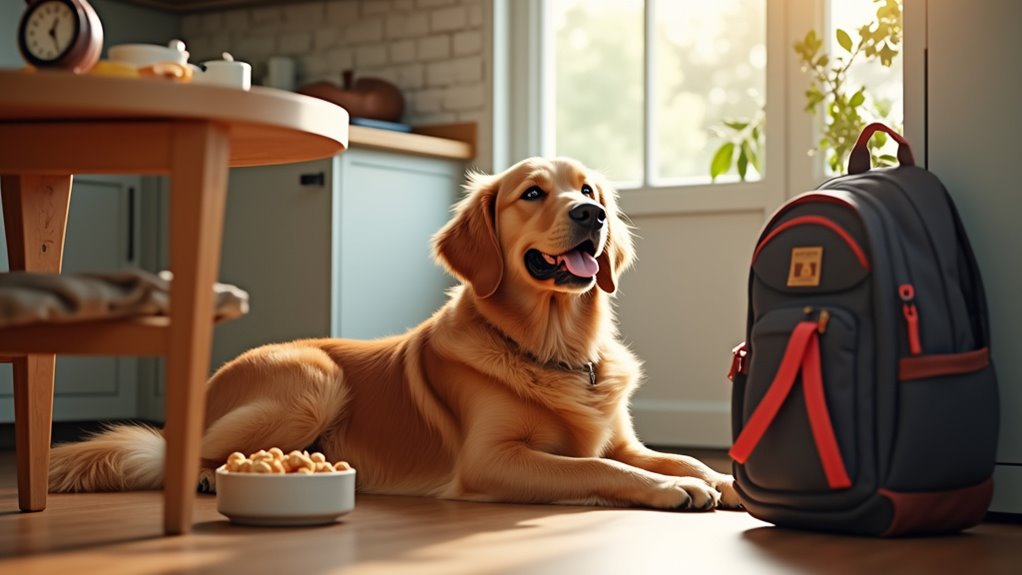To help your pets adjust to back-to-school schedule changes, establish a consistent routine by setting regular feeding, walk, and playtimes. Stick to these schedules to provide stability and reduce anxiety, especially during busy mornings. Create safe spaces where your pet can retreat if they feel overwhelmed. Stay calm and reassuring, and gradually introduce any shifts in routine. Remaining consistent now will make the transition easier—keep exploring for more practical tips to ensure your pet’s comfort.
Key Takeaways
- Maintain consistent feeding times to provide pets with a sense of stability and predictability.
- Incorporate scheduled walks, play, and rest periods aligned with new household routines.
- Create a safe, quiet space where pets can retreat during busy or stressful times.
- Gradually introduce schedule changes to help pets adapt without causing anxiety.
- Use calming aids and a calm demeanor to support pets through transitions and reduce stress.

As kids head back to school, it’s the perfect time to establish or update your pet’s daily routines, ensuring they stay happy and well-adjusted during the busy season. Changes in household activity levels and schedules can cause your pet to feel anxious or unsettled if they’re not prepared. One of the most effective ways to help them adjust is by maintaining consistent feeding schedules. Pets thrive on routine, and predictable meal times can provide a sense of stability, reducing pet anxiety that often spikes when their daily structure shifts. If you’ve been flexible over the summer, now’s the time to set clear times for feeding—whether it’s morning, afternoon, or evening—and stick to them as closely as possible. This consistency reassures your pet, making it easier for them to understand what to expect, which can considerably diminish their stress levels.
Along with regular feeding schedules, it’s important to create a predictable daily routine that includes walks, playtime, and rest periods. When your pet knows when to expect these activities, they’re less likely to become anxious or hyperactive. For example, taking a walk shortly after breakfast or dinner helps establish a natural rhythm for the day. Incorporating quiet time or a cozy corner where your pet can retreat when feeling overwhelmed also helps manage pet anxiety. During the busy back-to-school period, your pet might be more prone to feeling lonely or nervous, especially if household activity drops or routines are disrupted. Having a designated space where they feel safe and secure provides comfort and familiarity amidst the changes.
Communication is key. If your schedule shifts due to new commitments like after-school activities or work hours, gradually introduce your pet to these changes. Keep their feeding times consistent to avoid confusion, but adjust other activities gradually so they can adapt without feeling overwhelmed. You might also consider incorporating calming aids, like puzzle feeders or soothing music, which can help ease pet anxiety during transitional periods. Remember, pets pick up on your emotions, so staying calm and positive can influence how quickly they adjust to the new routine.
Frequently Asked Questions
How Can I Tell if My Pet Is Stressed by the Schedule Change?
To tell if your pet is stressed by schedule changes, look for pet behavior cues like excessive grooming, hiding, or lethargy. Stress indicators also include changes in appetite or increased vocalization. You’ll notice these signs if your pet feels uncomfortable or overwhelmed. Observe their daily behavior closely, and if you see these stress indicators, help your pet adjust gradually and provide reassurance to ease their anxiety.
What Are Quick Ways to Comfort My Pet During Transition?
To comfort your pet during the shift, try pet calming techniques like gentle massage or soothing sounds to ease anxiety. Maintain routine consistency by sticking to regular feeding, play, and rest times, which helps your pet feel secure. Offer a cozy space where they can retreat and feel safe. These simple steps can make the adjustment smoother, reducing stress and reassuring your furry friend during schedule changes.
Should I Adjust Feeding Times Before School Starts?
Think of your pet’s feeding schedule as a dance routine—smooth, predictable steps keep them comfortable. Before school starts, gradually adjust their feeding times to match the upcoming schedule. This helps your pet’s routines stay in sync, reducing stress. By easing into the new routine, you guarantee a seamless transition, making mornings easier for both of you. Small changes now set the stage for a calmer, happier pet during the busy school season.
How Can I Prevent Separation Anxiety When I Leave for School?
To prevent separation anxiety when you leave for school, start crate training your pet to create a safe space. Use calming scents like lavender in the crate to help your pet relax. Practice short departures, gradually increasing alone time, so your pet becomes comfortable being alone. Providing toys or puzzles can also distract them and reduce stress. Consistent routines and positive reinforcement help your pet adjust smoothly to your absence.
Are There Specific Toys or Activities to Keep Pets Occupied?
Think of your pet’s mind as a garden that needs constant watering with stimulating activities. You can keep it thriving by offering interactive toys and puzzle feeders, which challenge their brains and keep boredom at bay. These activities act like a mental workout, helping your pet stay engaged and happy while you’re away. Incorporate a variety of these toys into their routine to make sure they’re always curious and stimulated.
Conclusion
As you prepare for the new school year, remember you’re the steady lighthouse guiding your pet through this change. Their routines may shift like tides, but your patience and consistency are the unwavering anchor they need. Embrace these moments as a chance to strengthen your bond, turning each adjustment into a shared journey. With your calm presence, you’ll help your pet navigate this season of change, shining as their guiding star through the ebb and flow of routine.









